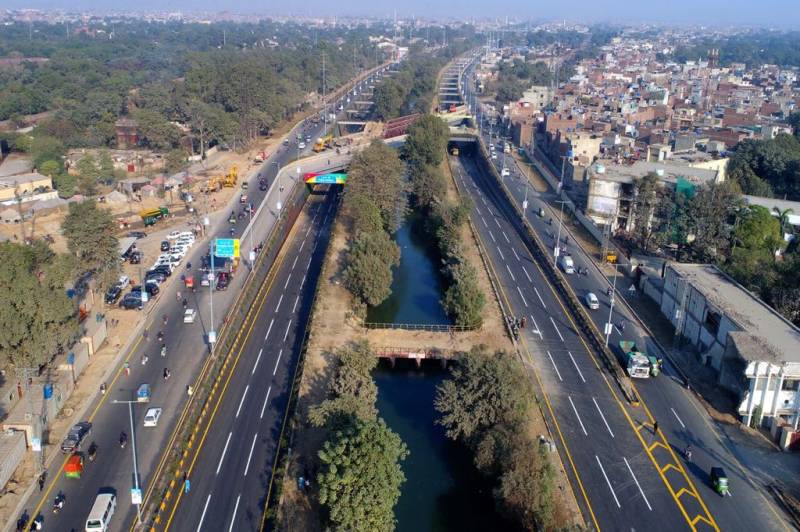The construction of Beijing underpass in Lahore undoubtedly is a landmark project, as it can accommodate 250,000 vehicles every day, greatly reducing traffic congestion on the canal road and its peripheries. The 1.3 kilometer underpass linking Dharampura to Mughalpura is the longest and deepest in Pakistan, which was built in record 125 days, costing 3.67 billion rupees.
The underpass is named after the capital of China, Beijing, which certainly highlights the longstanding relations between Pakistan and China, and especially to recognise China’s support in development projects in Punjab. Also, picture of pagoda style traditional Chinese building has also been drawn on the underpass walls through tile work, to demonstrate Chinese architectural elements.
This underpass is extremely significant due to the fact less traffic jams would now be witnessed on the canal road, which surely is another milestone towards making Lahore a signal free corridor. Then, 994 million rupees would be saved on fuel account, meaning less carbon emissions, and a great safety to the city’s environment. Moreover, this newly built underpass would directly lead to the Lahore Ring Road in a very quick time, thereby helping reduce traffic blockages in several surrounding areas as well. With all these significant aspects, it would not be wrong to say that Lahore’s Beijing underpass can easily be named among the world’s amazing and useful architectural projects.
Below is a list of some of the acclaimed construction projects around the world:
Akashi Kaikyo Bridge, Japan
Also known as the Pearl Bridge, Akashi Kaikyo, is a stunning sample of modern civil engineering. Located in Japan, this bridge is the world’s largest cable bridge and there are no pillars for the supports. It has the longest central span of any suspension bridge in the world, at 1,991 metres (6,532 ft). It was completed in 1998. The bridge links the city of Kobe on the mainland of Honshu to Iwaya on Awaji Island by crossing the busy Akashi Strait. It carries part of the Honshu-Shikoku Highway.

Millau Viaduct, France
The Millau Viaduct is a cable-stayed road-bridge that spans the valley of the river Tarn near Millau in southern France. It is the tallest bridge in the world with one mast’s summit at 343.0 metres (1,125 ft) above the base of the structure. It is the 12th highest bridge deck in the world, being 270 metres (890 ft) between the road deck and the ground below. It was completed on December 14, 2004. The bridge received the 2006 IABSE Outstanding Structure Award.

Three Gorges Dam, China
The world's largest dam is a mile and a half long and about 60 stories high. The $59 billion Yangtze River project was completed and put into service in 2003. Most extremely large construction projects have their detractors, but Three Gorges has been particularly criticised for displacing about 1.5 million persons and destroying hundreds of miles of viable farmland. Its electrical generation capacity is more than eight times greater than Hoover Dam, but still supplies only two or three per cent of China's 2016 energy needs.

Eurotunnel, England-France
This is an amazing sample of the Modern Engineering, this tunnel start from England and End in France. Interest thing is that this is in water. The length of this tunnel is 31 miles and 23 of which is in the sea.

North European Gas Pipeline, Russia-Germany
With two parallel lines, this offshore natural gas pipeline runs from Vyborg in Russia to Greifswald in Germany. This longest sub-sea pipeline had its first line laid by May 2011 and was inaugurated November 8, 2011; the second line was laid in 2011-2012 and was inaugurated on October 8, 2012.

Bailong Elevator, China
This glass elevator is the highest and heaviest outdoor elevator in the world, built onto the side of a 300 meter huge cliff in Wulingyuan area in China. It is also referred to as "Hundred Dragons Elevator". It can carry 50 people in one trip and takes two minutes to ride from the base to the top.

King Fahd Causeway
The King Fahd Causeway is a series of bridges and causeways connecting Saudi Arabia and Bahrain. The idea of constructing the causeway was based on improving the links and bonds between Saudi Arabia and Bahrain. Surveying of the maritime began in 1968, and construction began in 1981 and continued until 1986, when it was officially opened to the public.







